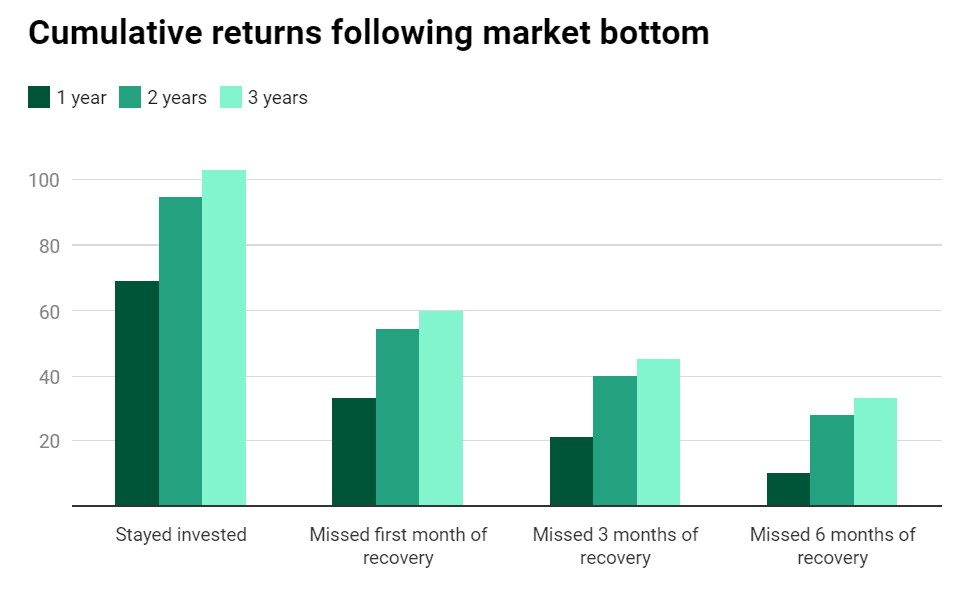Last month, we entered into Bear market territory in record time. In less than a month, the stock market U-turn dramatically and we are back in Bull market territory, characterized by a 20% appreciation from the low point.
Investors went from asking, ” How long more is the stock market going to crater”, to ” Are we looking at the start of a new bull market”?
The huge volatility seen in the stock market is undoubtedly confusing many.
In this Guest Post article from Syfe, we highlight 3 reasons to keep investing even in a downturn.
3 Reasons To Keep Investing Even In A Downturn
Much of life as we know it has grinded to a halt over the past week. Workplaces and schools have been mostly closed under the new COVID-19 circuit breaker measures, and the usual crowds and bustle of our shopping malls have fallen to ghostly silence. Buses and trains are running nearly empty as Singaporeans stay home to help fight the coronavirus.
To fill the void, people have been turning to breadmaking, whipping up dalgona coffee, and building home gyms. But for investors, this period can also be a time to seek opportunities. If you have a well-cushioned emergency fund and spare cash to deploy, investing more in the stock market during this time could be a smart move.
Reason #1: Stock up on quality investments at bargain prices
Warren Buffett famously said that investors need to be “greedy when others are fearful, and fearful when others are greedy”. As other investors flee, his mantra suggests that now could be a good time to cash in on lower equity prices.
The goal is to buy and hold these investments for the long term, giving them years to recover their value. An effective strategy for long-term investors to put their excess cash to work at discounted prices is by dollar cost averaging. By investing smaller amounts of cash into the market at regular intervals, investors can capitalise on lower prices now while avoiding the risk of buying all at once ahead of another market drop.
In uncertain times, investors may also want to seek additional peace of mind by investing for income. Real estate investment trusts (REITs), dividend stocks and bonds provide dividend income and investors can consider adding them to their portfolios during this time. Look out REITs and stocks that display strong fundamentals and resilient earnings growth. Not sure how to choose? Syfe’s ready-made portfolio of Singapore REITs and government bonds offers a low-cost, hassle-free alternative.
Reason #2: Keep your retirement (or early retirement) plans on track
If you’re investing for the future – say, making regular contributions to your retirement savings account – a short-term downturn is not a reason to stop investing. If you’re still working and drawing the same salary through this circuit breaker period – and you expect things to stay that way – stopping your contributions for this month or the next is counterproductive. Your utilities and other bill payments are, for the most part, still going to be similar to the amounts you have been paying. If anything, your expenses might even dip as more time is spent at home.
When it comes to saving and investing for long-term goals like retirement, time in the market is key. Missing out a few months can have an outsized impact on your nest egg. An investor who puts in $1,000 every month, assuming a conservative average return of 5% per annum, will have amassed around $411,000 after 20 years. But an investor who stops investing for just four months will have about $11,000 less. When it comes to building wealth for your golden years, time is the greatest ally you have. So stay on track with your contribution plan – your future self will thank you.
Reason #3: Pulling out of stocks penalises you
Investors should always ensure that their investments align with their risk tolerance. That way, they don’t risk selling out before they can reap the full investment gains. But what should you do when the market has already fallen and you realise your risk exposure is out of sync with your risk appetite?
For now, the best option may simply be to hang on tight. During the 2008 global financial crisis, those who stayed invested in the S&P 500 recorded twice the returns of those who fled to cash for as little as three months.

Making drastic changes to your portfolio such as selling all your stocks now means crystallising your losses. But by holding on, you’re already in position to capture the gains when the market inevitably bounces back.
Once the market starts to recover, think about cushioning your portfolio against future market downturns. That could mean reviewing your risk profile and adjusting your asset allocation accordingly. Investors can also consider adopting a dynamic risk-management strategy where their allocation to less-risky bonds and gold is automatically increased before further market declines.
Nobody knows for sure how the COVID-19 situation will play out. But by staying invested and disciplined, while looking out for good investment opportunities, investors can emerge from this storm stronger – and even wealthier.
Join our Telegram broadcast: https://t.me/gemcomm
SEE OUR OTHER WRITE-UPS
- HOW TO BUY REITS IN SINGAPORE. 10-KEY S-REIT QUANTITATIVE FILTER (PART 1)
- WHICH ARE THE BEST TAX-EFFICIENT ETFS TO INVEST IN?
- ARE YOU OVERPAYING YOUR REIT MANAGER? WHICH S-REITS HAVE THE “HIGHEST” MANAGEMENT FEES?
- WHICH S-REITS HAVE THE BEST RECORD OF DIVIDEND GROWTH?
- 10 GREAT REASONS FOR REITS INCLUSION IN YOUR PORTFOLIO AND 3 REASONS TO BE CAUTIOUS
- WHY I AM STILL BUYING REITS EVEN WHEN THEY LOOK EXPENSIVE
Disclosure: The accuracy of the material found in this article cannot be guaranteed. Past performance is not an assurance of future results. This article is not to be construed as a recommendation to Buy or Sell any shares or derivative products and is solely for reference only.









